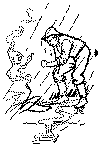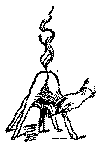By Dan Beard

Fig. 312
The Fire Won't Burn
Lafe, I can't make a fire; we have no paper and the wood's all wet."
Lafe is a Pike County backwoodsman. He only smiled; then shouldering his axe he walked over to a moss-covered log that lay on the ground as soggy and wet as a sponge in the water. With a few blows from the butt end of his axe he knocked out of the rotten wood the remnants of what were once the noble limbs of a giant pine tree. These remnants were now nothing more than spike-shaped clubs, the largest not over two feet long.

Fig. 313.
A "Fat" Pine Knot.
"Here's what we use in the woods for paper," said Lafe. Upon examination, we discovered that the spike-shaped clubs were almost as heavy as lead, but it was not water that gave them the weight; it was the sap of the tree, the pitch, that colored them a rich red and made them hard and impervious to rain. Lafe pulled out his one-bladed jackknife and began to whittle the pine stick, but he allowed no shavings to become detached (Fig. 313).

Fig. 314.
Starting the Fire.
When he had three cut in the manner shown in the accompanying drawing (Fig. 314), he set them up on the ground, with the small ends down and the big ends resting against each other, placed as the sticks are that form the frame of an Indian wigwam. He touched a lighted match to the shavings, and immediately a flame burst forth with a black smoke. Selecting some sticks he had previously split in halves, he piled them around the blazing pine-knots in a conical wigwam fashion, and soon we had a fire that was hot enough to ignite the wet, unsplit wood we gathered.
Building a Fire Without Matches
After the coffee was boiled and the fish fried and the Boy's clothes partially dried, they made baste to ply Lafe with questions.
"How would you build a fire, if your matches were wet, or if you had none?" asked Tom.
"I generally calculate to keep my matches dry and always keep some about me," answered the woodsman but in case, as you say, I had none, I'd put a light charge of powder in my gun and a loose wad of cotton rag and shoot in the air, and then double the red-hot ashes of the rag up and blow on it until it flamed up.
"Or, if I that I am running out of matches, I take piece of cotton and and dry it at the fire, heating it until it is almost charred; then I dampen the rag and rub gun-powder into its fibers as hard as I can until I can rub no more powder in. After that I dry the rag thorough1v again and put it in a bottle, tin box, or horn, cork it up tight and keep it until I need it. With the back of my knife-blade for a steel and a piece of flint, I strike a spark that sets the rag a-burning and fold the glowing rag tip, cover it with shavings, twisted straw or punk, and blow it into a flame."
Things Worth Remembering
"Tamarack is a very good wood, If you can get it dry, But to make a fire of green tamarack, I'll be a fool to try."
An Indian builds a small campfire and hugs it, a white man makes a roaring big fire and stands away from it.
In selecting a camping-place never forget that the presence of good firewood in abundance is a matter of grave importance. A standing dead cedar will furnish the best of kindling wood. Green, soft woods, spruce, and white birch, burn badly and are difficult to ignite.
To build a fire that will burn all night, select a couple of good heavy sticks for andirons, and a quantity of green hardwood, maple, yellow birch, or beech, for fuel. Across the andirons lay all the fuel sticks in the same direction parallel with each other; in this position they will burn slowly and smolder for a long time. A large tree, or, better still, a large rock at the back of your fire will retain and reflect the heat.
Always select a well-drained spot, or a slight elevation for a place to pitch your tent or build your shack; this will prevent an exceedingly disagreeable experience of awakening during a rain storm to find your tent, floor, and blankets soaked with water. The presence of a neighboring spring, or other water-supply for drinking and cooking, of course, must not be overlooked.
Never pitch your tent in a hollow or depression, or you may find yourself in the middle of a pond. The floor, which is often your bed, can be covered with straw, if straw is obtainable; if not, fir-boughs; these lie flatter than spruce. It is best to lay the foundation of good-sized branches, cover them with smaller ones, and over all place a deep layer of fir twigs broken off the length of your hand, and laid shingle-fashion, commencing at the foot of your bed, or the doorway of your shack or tent, each succeeding row of boughs covering the thick ends of the previous row. A properly made bough bed is as comfortable as a mattress, but one in which the ends of the sticks prod your ribs all night is not a couch that tends to make a comfortable right's rest.
Candles, lamps, and lanterns add to the luggage of a camper, and may be dispensed with, yet it often happens that you will need a light at night. If you do, remember that almost any sort of fat or grease will burn. I have made a passable lamp of an old clam-shell filled with melted rancid butter and a twisted rag for a wick resting in the butter, and I have seen most dainty little candies molded in willow bark of tallow from the deer, with a wick of the inside bark of a cedar-tree. But such things are only made by guides for ladies, or as souvenirs to take home. A torch will answer all needs of camp life.